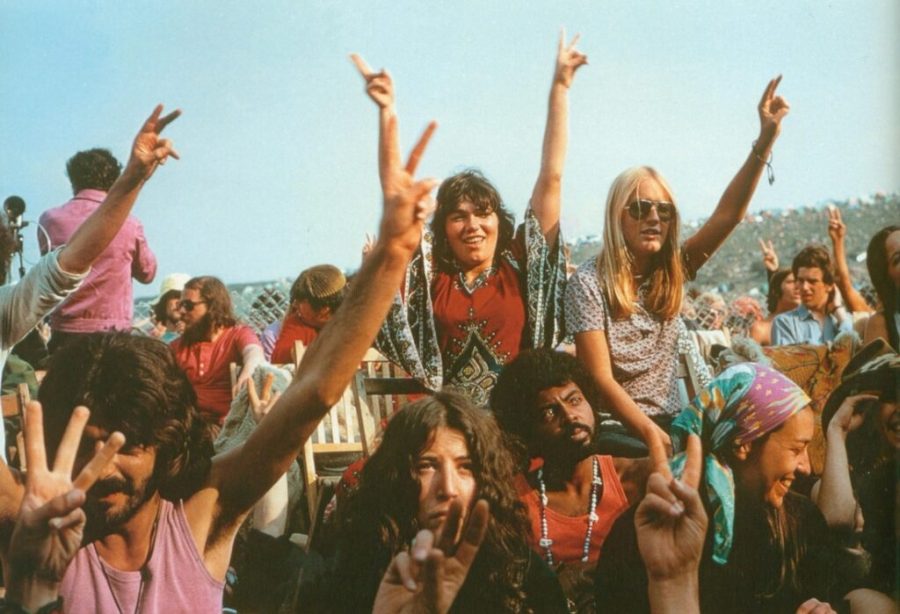The Influence the Hippie Era Had on Fashion
February 2, 2023
The sixties were taken up by a subculture that rejected social norms mainly known as hippies. They were famous for their unconventional way of dressing and constant protests against violence. As time went on, one can see that this era had a major influence on fashion today. From the bell bottom pants to the long flowy skirts, the hippie style isn’t going anywhere.
I had the pleasure of traveling to Woodstock to meet with Gillian Ferrell, an actress, writer, and director, who lived, and participated in, the notorious hippie movement of the 1960’s.
There was an uproar in the fight for peace and love during the time of the Vietnam War. A new sense of normal arose, allowing people to be free to celebrate who they were. The burning of the bra was a major trend in the 60s that represented a new free spirited way of life. “It just did something to everyone’s head,” stated Ms. Ferrell, “all of a sudden we [women] didn’t have to wear bras anymore. We didn’t quite know what was coming, but we weren’t going to be like our mothers. We were going to do something different. It was really a social movement along with a political one.” There was a change for women’s rights during this period of time, and a lot of it started with clothing.
According to Ms. Ferrell, “there was a whole movement to go back to the earth.” People wore flowy clothing as a way to connect with nature. Ms. Ferrell then continued, “people used to only wear skirts to the middle of the knee, and all of a sudden people were wearing long skirts and mini skirts. Then there was this whole flower power idea. Flowers were everywhere. In people’s hair, in the fabric of their clothing, and even along the walls of their homes.” This new style even impacted footwear. “Sandals were a big thing, and so was being barefoot. Even in cities. I once walked around Montreal barefoot. It was so freeing,” she stated.
Color erupted in the clothing department as well as arts and crafts. “There was a huge thing on macrame,” said Ms. Ferrell, “women were wearing a lot of crocheted items.” People appeared to come up with crazy ideas for outfits, and would just put random items of clothing on. Ms. Ferrell then said, “We’d [the hippies] take pieces of clothing from other times/eras and wore them in different ways. For example, a guy would wear a top hat and a tuxedo along with jeans and make an outfit out of it. It was just such a creative time.”
Ms. Ferrell also mentioned the influence Eastern European and Indian culture had on the hippie movement. “So once the whole hippie movement got started people, like musicians, would go to places like India where they were influenced by people like Robbie Shankar. The hats, the beautiful outfits, the jewelry and bracelets, the whole Eastern influence had a huge impact on all of us.”
Ms. Ferrell talked about what the musicians, and the music industry at that time, did for the hippie movement. “The music of that era really led the whole thing, and, of course, people started dressing like the stars. Janis Joplin, for example, she would put feathers in her hair. She did whatever she wanted to do, and, of course, gave everybody ideas on how wild they could make their outfits.”
Another example of something people got creative with was makeup. In the beginning of the era, makeup was usually kept very natural. According to Ms. Ferrell, “Carnaby street came in, and women started doing crazy makeup. Twiggy [a famous model during that time] was known for her long eyelashes. She would do these painted on long eyelashes, and make her eyes really big. Which helped influence the hippie look.”
Going back to the making of one’s own clothing, beads played a major role in the hippie time period. “The whole idea of wearing all these beads started with the Vietnam War,” said Ms. Ferrell, “they were called love beads because we [the hippies] wanted love and peace rather than war. So people started wearing these beads, and making stuff out of them.”
When asked whether or not Ms. Ferrell believed this movement was a statement she replied, “I do think there was a reaction to the old way of doing things. The real energy behind it was the war. I was in school, and one of the guys in my class joined to go up and died. Those who went to war were coming back as drug addicts and dying. That’s why we [the people of this time period] were saying we don’t want war anymore. It was all about peace.”
A new world blossomed during the 1960s and fashion played a major part in changing it. The style, and motto, of the hippies will live on forever. Staying true to oneself, and embracing yourself through clothing is a lesson that everyone should carry on from this time period. The fashion industry has grown so much from this “groovy” way of fashion, and still continues to grow. Without the hippie movement, a lot of our favorite outfits today wouldn’t be around.


















